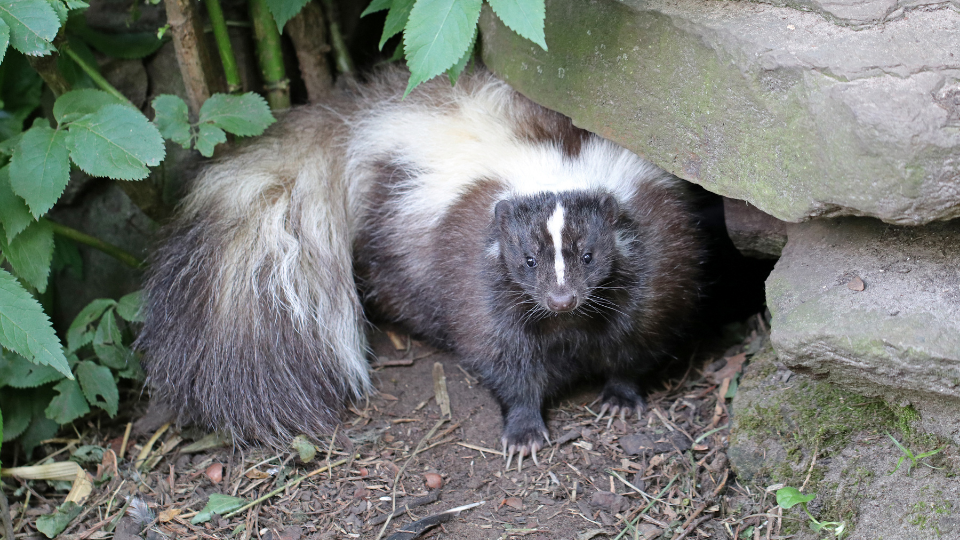Not sure how to get rid of skunks around your home? Although these bushy-tailed, black and white striped creatures are small, their disgusting odor is quite overwhelming and potent. Skunks have the ability to spray an extremely foul-smelling spray into the air when threatened or frightened. Unfortunately, this smell can linger for weeks. Not only are smelly skunks quite repulsive to deal with, they can also be quite dangerous. According to Terminix, a well-known pest control company, skunks are a main source of rabies in many areas around the country. Other diseases and parasites that affect skunks include distemper, mange, fleas, ticks, lice, roundworms, and tapeworms. Skunks are also carriers of diseases, including leptospirosis, listeriosis, canine distemper, canine hepatitis, Q-fever and tularemia. Yikes! Keep in mind, though, that skunks are not aggressive by nature – unless they are infected with rabies. In addition to being downright gross, skunks can also wreak havoc on your yard and garden by burrowing and foraging underground. Ready to eliminate your skunk problem? Here’s how to get rid of skunks in and around your yard.
Signs you have a skunk problem
- You smell them – Get a whiff of that nasty skunk smell? If so, you most likely have a skunk problem – especially, if you’ve smelled it on more than one occasion. Smelling a skunk’s distinct odor around your yard is the most common and obvious sign that your home has a skunk problem that needs to be addressed. Keep in mind, though, that skunk spray can be smelled from several miles away. In fact, according to Pest Pointers, humans can smell a skunk from up to 3.5 miles away, depending on whether or not there’s a draft blowing the smell in your direction. If you suspect the smell is coming from far away – or if you’ve only smelled the skunk once – then don’t worry quite yet. However, if you’ve smelled the skunk odor more than once, and it’s a recurring annoyance, then it’s time to start thinking about a skunk removal plan.
- You spot a skunk in the yard –Have you seen a skunk (or several) in your yard? Unfortunately, that’s a sure-fire sign that you’ve got skunk problem. While it’s unlikely that you’ll see skunks, given their nocturnal nature, these creatures do occasionally move around during the daytime. Skunks are typically most active at night. According to Havahart, skunks do not hibernate during cold months, but they do tend to be less active. Skunks are typically most active during the spring (due to mating season) and during the fall before that winter chill sets in.
- You see holes in your yard – Does your garden or lawn look slightly damaged? Unfortunately, skunks can destroy plants and vegetation, if left to their own devices. These creatures dig 3 to 4-inch holes in the ground in search of grubs and food. Skunks eat mostly ground worms, insects, berries, birdseed and fruit. They are attracted to grassy areas, which is why a lawn or garden is particularly at risk. If you notice holes in your yard (particularly during the spring months when skunks are most active), then you may have a skunk problem that needs to be addressed as soon as possible.
Steps to address your skunk problem
1. Eliminate access to food, water and shelter
According to the University of California’s Statewide Integrated Pest Management Program, “the most effective way to make your property less attractive to skunks is by reducing access to food, water and shelter that the animals need.” This means removing bird feeders and fallen fruit, making sure garbage can lids are tight and secure, removing food from compost bins and feeding pets indoors. You can also try spraying your grass with grub killer, if this seems to be the skunk’s main source of food. By reducing and/or removing food sources from your lawn and garden, you should be able to eliminate the skunk problem without having to resort to extreme measures.
2. Seal entry points and exclude skunks from entering the home
Worried about skunks entering your home premises? If so, then it’s time to begin exclusion work. This means sealing off potential entry points, such as crawl spaces and underneath porches and decks. You want to make sure you block the entry points prior to skunks nesting in and around your home. Otherwise, they could become trapped underneath the home. One way to block entry points is by placing mesh fencing around your crawl space, porch, garden shed, deck and any other place where skunks are likely to dig.
3. Set a trap
If all else fails, you may need to set a live trap. However, depending on the extent of your skunk problem, this is oftentimes best left to the professionals. If you decide to set a live trap yourself, head to your local hardware store to find either a box trap or wire trap. Place bait inside the trap and leave the trap in a place where you believe skunks are located. For bait, we recommend using anything from cat food and bacon to sweet fruits, such as apples or bananas, and peanut butter. The University of California’s Statewide Integrated Pest Management Program states that “individuals who have no experience trapping skunks should hire a professional wildlife control operator.” A professional trapper is less likely to end up being sprayed and will know how to properly dispose of the skunk once it is caught. Due to the potential for rabies and other diseases, we do not recommend ever holding or handling the skunk yourself.
Referenced from moving.com site

